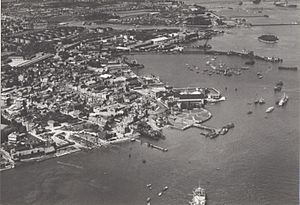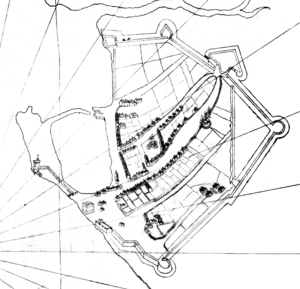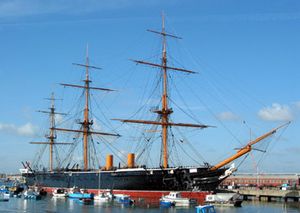History of Portsmouth facts for kids
Portsmouth is an island port city located on Portsea Island in Hampshire, England. Its long history has been shaped by its strong connection to the sea, its closeness to London, and its easy access to mainland Europe.
Contents
Early History of Portsmouth
Even before Roman times, people lived in the area around Portsmouth. A Roman fort called Portus Adurni, later known as Portchester Castle, was a major naval base.
Portsmouth itself is generally thought to have been founded in 1180 by a man named John of Gisors. Many early records of the city were likely lost during the Norman Conquest. However, some old texts mention "Portesmūða" (meaning "mouth of the harbour") as early as the 9th century.
Medieval Portsmouth: Growth and Challenges
In the Domesday Book, Portsmouth isn't mentioned directly, but other settlements that later became part of the city are listed. These include Buckland, Copnor, and Fratton on Portsea Island. Back then, the area probably had only a few hundred people.
Portsmouth's first proper church was built in 1181. It was a chapel dedicated to Thomas Becket, built by monks from Southwick Priory. Today, the Portsmouth Anglican Cathedral stands in the same spot.
In 1194, King Richard I (also known as Richard the Lionheart) gave Portsmouth its first royal charter. This important document allowed the city to hold a yearly fair, weekly markets, and set up a local court. It also meant the city didn't have to pay a yearly tax, and could use that money for local matters instead.
King John later confirmed these rights in 1200. His desire to invade Normandy led to Portsmouth becoming a permanent naval base. In 1212, the first docks were built in Portsmouth. Around the same time, the Domus Dei (a hospital and almshouse) was founded, helping the sick and needy.
During the 13th century, kings Henry III and Edward I often used Portsmouth as a base for attacks against France. However, the city also faced dangers. In 1265, raiders from the Barons of the Cinque Ports attacked, burning down much of the town.
By the 14th century, Portsmouth's trade grew, especially in wine from France.
French Raids and the Black Death
In 1338, a French fleet tricked its way into Portsmouth docks and burned down most of the buildings. Only the church and Domus Dei survived. To help the town rebuild, King Edward III freed the people from national taxes.
Just ten years later, the terrible Black Death plague hit Portsmouth for the first time. The French also attacked the city again in 1369, 1377, and 1380.
In 1418, King Henry V ordered a wooden Round Tower to be built at the harbour mouth, which was finished in 1426.
Tudor Period: Fortifications and Famous Ships
During the Tudor period, Portsmouth's defenses were constantly being improved. King Henry VIII had the Round Tower rebuilt in stone and a Square Tower added. Britain's first dry dock was also built in Portsmouth around this time.
In 1527, Henry VIII used money from closed monasteries to build Southsea Castle. In 1545, he watched from this castle as his famous warship, the Mary Rose, sank nearby during a battle with the French fleet, taking about 500 lives with her. Portsmouth also gained its first military governor during this period.
In 1563, a plague struck the city, killing around 300 people.
Stuart Period: Civil War and Rebuilding
During the English Civil War, Portsmouth was first held by the King's supporters (Royalists) but then taken by Parliament's forces after a siege in September 1642.
In 1665, King Charles II of England ordered the rebuilding of Portsmouth's defenses, a huge project that took many years. Roads connecting Portsmouth to London also began to improve.
18th Century: Newspapers and New Beginnings

The city's first local newspaper, the Portsmouth and Gosport Gazette, started publishing in 1745.
A very important event happened on 13 May 1787. The First Fleet of ships left Portsmouth Harbour carrying the first British settlers to Australia. They arrived in Botany Bay on 18 January 1788. A memorial in Portsmouth, unveiled by HM The Queen in 1980, remembers this journey.
Modern Portsmouth
Admiral Nelson left Portsmouth for the last time in 1805 to lead the fleet that would win the famous Battle of Trafalgar. Because the Royal Navy relied so much on Portsmouth, the city became one of the most fortified places in Europe, surrounded by many forts.
From 1808, the Royal Navy's West Africa Squadron, which worked to stop the slave trade, operated from Portsmouth.
New ways to travel were built in the 19th century. In 1823, the Portsmouth and Arundel Canal opened, offering a waterway to London, but it closed just four years later. Portsmouth got its first railway link in 1847, with a direct route to London opening in 1859.
A major scientific journey, the Challenger Expedition, started from Portsmouth on 21 December 1872.
20th Century: City Status and War

In 1904, Portsmouth's boundaries were expanded to include all of Portsea Island. The city's boundaries grew even more in 1920 and 1932, taking in parts of the mainland.
Portsmouth was officially made a City on 21 April 1926.
The Portsmouth Blitz
During the Second World War, Portsmouth was heavily bombed by Nazi German planes. This was because it was home to a major Royal Navy Dockyard. Air raids began on 24 August 1940, with many bombs dropped on the city. The Guildhall, churches, schools, and over 80,000 homes were damaged. Sadly, 930 people were killed and many more were injured. This extensive bombing meant a huge need for new housing after the war. Even today, builders sometimes find unexploded bombs.
D-Day Landings
Southsea beach and Portsmouth Harbour were important starting points for the D-Day landings on 6 June 1944. Southwick House, just north of Portsmouth, was chosen as the headquarters for the Supreme Allied Commander, US General Dwight D. Eisenhower, during D-Day.
A Hero's Return and University Status
On 4 July 1968, about 250,000 people gathered to welcome Alec Rose back to Portsmouth. He was a local greengrocer who had just finished sailing solo around the world in his boat, Lively Lady. He was knighted and made a "Freeman of the City" right away.
The University of Portsmouth became a full university in 1992, after being a polytechnic since 1969.
21st Century: New Landmarks and Events
In 2003, construction began on the 552-foot-high Spinnaker Tower at Portsmouth Harbour. Completed in 2005, this tower celebrates the city's strong connection to the sea. It has an observation deck at the top, offering amazing views of the city and harbour.
In 2004, the Tricorn Centre, once called "The ugliest building in the UK," was finally pulled down after many years of debate.
In 2005, Portsmouth was a key location for Sea Britain, a series of events marking 200 years since Lord Nelson's victory at the Battle of Trafalgar. This included a huge Fleet Review by HM Queen Elizabeth II.
Recent Developments
In 2011, a census showed that Portsmouth has a very high population density, meaning many people live close together.
In 2017, a World War II bomb was found in Portsmouth harbour during dredging work. It was safely towed out to sea and detonated. Also in 2017, HMS Queen Elizabeth, the first of the huge Queen Elizabeth-class aircraft carriers, was officially welcomed into Portsmouth. At 280 meters long, she is the largest ship ever to enter Portsmouth Harbour. Her sister ship, HMS Prince of Wales, joined her in 2019.
In 2019, Portsmouth celebrated the 75th anniversary of the D-day landings with big events on Southsea Common.
More recently, in 2020, the construction of the Southsea Coast Defense Scheme began. This huge project will redevelop a 2.8-mile stretch of coastline to protect it from the sea.
In 2021, the Spinnaker Tower was repainted back to its original white color. Also, plans were announced to improve Fratton Park stadium, the home of Portsmouth F.C..
In 2022, the USS Gerald R. Ford, the world's largest warship at 337 meters long, visited The Solent, making her the largest ship to anchor there.
Portsmouth continues to be a busy and important city, with its history and future deeply connected to the sea.
Images for kids
-
Portsmouth Harbour, taken from Gosport showing Portsdown Hill in the centre and the city of Portsmouth on the right including the home of the Royal Navy, HMNB Portsmouth.




